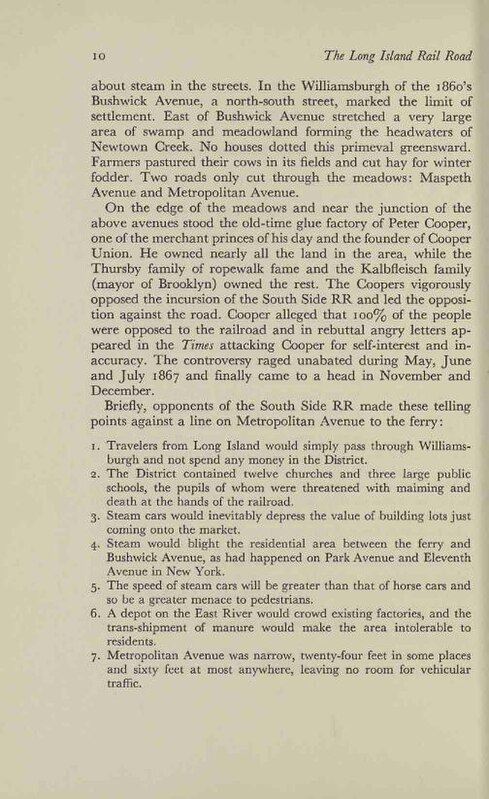about steam in the streets. In the Williamsburgh of the 1860's Bushwick Avenue, a north-south street, marked the limit of settlement. East of Bushwick Avenue stretched a very large area of swamp and meadowland forming the headwaters of Newtown Creek. No houses dotted this primeval greensward. Farmers pastured their cows in its fields and cut hay for winter fodder. Two roads only cut through the meadows: Maspeth Avenue and Metropolitan Avenue.
On the edge of the meadows and near the junction of the above avenues stood the old-time glue factory of Peter Cooper, one of the merchant princes of his day and the founderof Cooper Union. He owned nearly all the land in the area, while the Thursby family of ropewalk fame and the Kalbfleisch family (mayor of Brooklyn) owned the rest. The Coopers vigorously opposed the incursion of the South Side RR and led the opposition against the road. Cooper alleged that 100% of the people were opposed to the railroad and in rebuttal angry letters appeared in the Times attacking Cooper for self-interest and inaccuracy. The controversy raged unabated during May, June and July 1867 and finally came to a head in November and December.
Briefly, opponents of the South Side RR made these telling points against a line on Metropolitan Avenue to the ferry:
1. Travelers from Long Island would simply pass through Williamsburgh and not spend any money in the District.
2. The District contained twelve churches and three large public schools, the pupils of whom were threatened with maiming and death at the hands of the railroad.
3. Steam cars would inevitably depress the value of building lots just coming onto the market.
4. Steam would blight the residential area between the ferry and Bushwick Avenue, as had happened on Park Avenue and Eleventh Avenue in New York.
5. The speed of steam cars will be greater than that of horse cars and so be a greater menace to pedestrians.
6. A depot on the East River would crowd existing factories, and the trans-shipment of manure would make the area intolerable to residents.
7. Metropolitan Avenue was narrow, twenty-four feet in some places and sixty feet at most anywhere, leaving no room for vehicular traffic.
